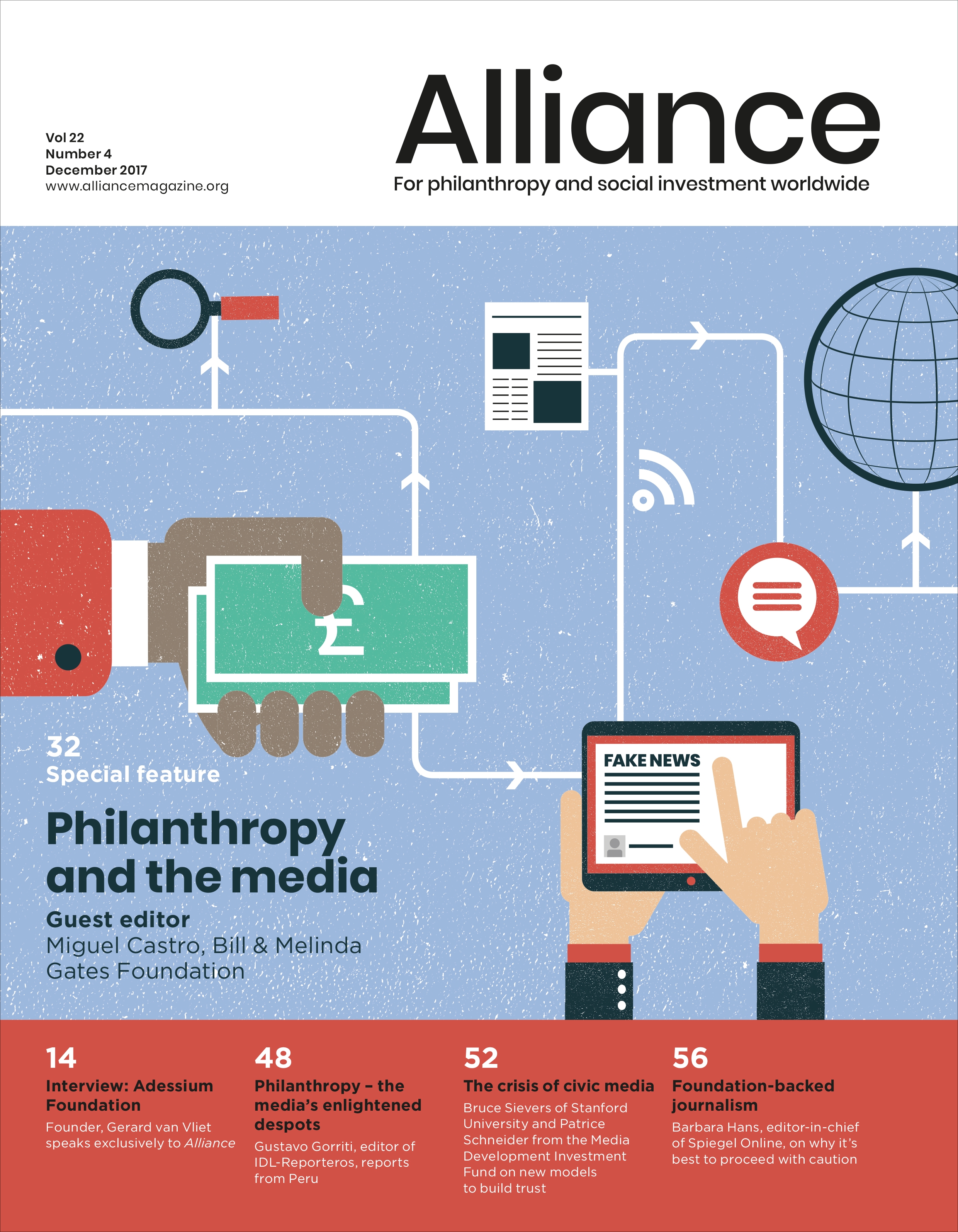Many are starting to ask whether general support for journalism as an end in itself should constitute a valid focus of philanthropy; given the recently renewed acceptance of the idea that news gathering and reporting constitutes a vital part of a healthy democracy.
This is really where the crux of the recent upsurge of interest in philanthropic funding for the news media lies.
We are two people (who happen to be married) who study philanthropy and journalism usually separately.  The key question we asked ourselves in considering the informative recent Alliance special feature on philanthropy and the media is: ‘What does each side want from this relationship?’
The key question we asked ourselves in considering the informative recent Alliance special feature on philanthropy and the media is: ‘What does each side want from this relationship?’
From the perspective of philanthropy, providing general support for the media is probably where there is most to be gained.
Not only could support for general, non topic-specific journalism potentially play an important role in addressing some of the key challenges facing our society today in terms of division and the degradation of the public sphere, but it could also help philanthropy to address one of its own big challenges: namely the way that it can distort democracy.
A charge often levelled at big money philanthropy is that it offers those with substantial wealth a means of sidestepping standard mechanisms of democratic governance and accountability in order to pursue their own priorities. Critics argue that even when well-intentioned, the sheer scale of some philanthropy and the level of influence of the individuals involved means that it has a distorting effect on public policy and spending priorities.
For funders who acknowledge this challenge – and not all do – , and want to find ways to minimise any democratic deficit they might create, supporting journalism provides one viable means of doing so.
By ensuring that there is a free press which can provide independent and trustworthy information, and challenge those in power, philanthropic funders can help to maintain the system of checks and balances that keeps democracy functioning.
If support for journalism on these grounds is to play a part in addressing the criticisms that philanthropy is anti-democratic, then as Bruce Sievers and Patrice Schneider argue: ‘a fundamental challenge for philanthropic funding of media organizations is the need to create a firewall between the donor and content. This relates not only to ideological or political influence, but also to general subject matter choice.’
If there is no such firewall, the danger is that a philanthropist’s support for the media merely becomes a tool to entrench their power even further.
And the evidence suggests that the current focus is very much on topic-specific funding: Eric Karstens reports in the Alliance feature that ‘between 2011 and 2014, just 7 per cent of funding went into unrestricted operational support for news organizations,” and that overall, “more than two thirds goes towards what could be described as services: awareness campaigns for social or other charitable causes… or otherwise information-oriented platforms.’
Yet the demand for independence of content choice and editorial line raises significant challenges.
If we take this position to its logical conclusion, then a philanthropic funder must accept that their support for a journalistic organisation would not preclude that organisation conducting investigations or publishing material that was critical of them.
While this is an especially important consideration to the philanthropy media – titles like Alliance and Stanford Social Innovation Review – which cover philanthropy, it is also true of the general media.

In 2010 hundreds of Mexican journalists silently marched in downtown Mexico City in protest of the kidnappings, murder and violence against their peers throughout the country. Photo credit: Knight Foundation.
As The Guardian’s Rachel White suggests , ‘receiving support from philanthropy does not mean that we would ever shy away from criticizing philanthropists or private foundations when warranted.’
But how many funders are truly enlightened or confident enough to accept this risk?
This may be one reason that, as Gustavo Gorriti wryly observes : ‘There is a great disparity between the consensus on the importance of free, investigative journalism for the health of democracy and the very small percentage of philanthropy allocated to support it.’
Ensuring journalistic independence is not only important for bolstering the democratic legitimacy of philanthropy, however. It is also important if the journalism itself is to be seen as credible.
People are often sceptical about the impact that commercial proprietors and advertisers have on news outlets, and it is naive to expect philanthropic funding sources to be exempt from this kind of scrutiny, particularly if such funding continues to expand.
Some of this scepticism – or at least caution – is warranted. Philanthropic funding of journalism is problematic; but so are other funding models.
There is currently a broader and extremely unhealthy strain in society of dismissive cynicism about the motives of the news media as a whole.
This cynicism has helped fuel the phenomenon of what are often described as ‘filter bubbles’ or ‘echo chambers’.
Faced with a fragmented news eco-system, abetted by social media algorithms, consumers retreat to sources and stories which corroborate and strengthen their own world view, thus exacerbating the problem further.
If philanthropic funders wish to use support for journalism as a way of healing societal division and restoring the ‘imagined community’ of national civic society, they cannot simply preach to the converted.
Of course, none of this is to suggest that there’s not room for foundations to adopt a more pragmatic engagement with journalism. For instance, a funder interested in the eradication of malaria may see support for media that raises awareness as an important part of their overall strategy for tackling the disease.
But the most enlightened philanthropy can and must do much more. It needs to find ways of breaking people out of their filter bubbles and getting news consumers to engage with sources that provide trustworthy factual information or a range of viewpoints on issues.Independence is once again vital here: if a philanthropic funder steers the direction of content and editorial line, then the journalism is likely to be seen as agenda-driven.
Likewise, if a funder’s interests dictate a focus on a narrow range of issues, there is significant danger that any journalistic output will merely end up circling around the same niche audiences rather than broadening those issues out to a wider audience.
Here too is a challenge for the philanthropically-funded journalist: the freedom from the commercial imperative to attract readers (or viewers/ listeners) could allow reporters and editors, especially those with commitments, however laudable, to particular issues or causes, to lose sight of their audience.
News organisations that don’t financially have to attract an audience must somehow remain committed to doing so, rather than to producing journalism that serves only their own (and their funders’) pet interests.
This need always to consider the audience raises another crucial point. It is insufficient for philanthropy to focus only on the ‘supply side’ of journalism, i.e. the funding of its production.
It must also play an active role on the ‘demand side’ by helping to build an audience for quality news and journalism.
This is important, as otherwise there is a real danger that philanthropic money will end up being spent on a plethora of well-intentioned fact-checking initiatives or niche media outlets that do great work but reach a limited audience and thus have negligible impact.
Giving consideration to the demand side of the news equation also minimises another danger: namely the risk that philanthropy could otherwise become a crutch, propping up journalism in perpetuity rather than buying it the time and space the industry needs to develop its own, viable funding models for the digital age.
Any idea that philanthropy could or should be the long-term financial solution to journalism’s problems is fraught with difficulty, not least because philanthropists and philanthropic funders are unlikely to fund anything in perpetuity – either because their interests or focus shift over time, or because they want their funding to be catalytic and thus always have an exit in mind.
There are also dangers attached to creating a social norm that journalism is a ‘charity case’, something for which philanthropy picks up the tab rather than something that society at large should engage with and be prepared to pay for.
Using some philanthropic funding to develop, through education, a broad audience that is able to identify, and willing to pay for, journalism could thus help to ensure longer-term sustainable funding models for media organisations, and thus an exit for funders.
When it comes to creating demand, media outlets might also choose to make explicit appeal to the public value of journalism. The recent surge in subscriptions reported by outlets such as the New York Times and the Financial Times may at least in part be down to the renewed interest in the societal value of journalism highlighted above.
The Guardian has made this rationale even more overt, by asking readers of its freely-available online content to make a voluntary contribution of as little as £1 on the basis that ‘independent, investigative journalism takes a lot of time, money and hard work to produce’ and that they believe ‘our perspective matters’.
And this approach appears to be bearing fruit: in October 2017 it was reported that 800,000 people had supported the newspaper financially in the previous 12 months, and that included more than 300,000 individual one-off contributions from readers in more than 140 countries.
The newspaper has also launched a US vehicle, Guardian.org to allow it to access to bigger foundation grants. The challenge for both philanthropic funders and media organisations when it comes to engaging on the basis of the social value of journalism will be to quantify that value.
Given what we have said about the importance of independence, it is obvious that any measures cannot be linked to specific cause-related outputs as that would almost certainly skew focus towards delivering those outputs and thus compromise the funding relationship.
But how, then, do we measure the wider public good generated by broad-based journalistic endeavours without simply resorting to assertion or anecdote?
Or do we simply have to take this public good as an article of faith?
That seems unlikely to wash in the long term. Philanthropy is not a white knight for the funding challenges facing the news media.
Neither will supporting media organisations automatically absolve philanthropic funders from the charge that they exert a distorting effect on democracy.
However, if the approach and terms of engagement are right, the two can gain a lot from each other when it comes to addressing both of these challenges and also achieving the shared goal of increasing public good through quality, fact-based journalism.
Rhodri Davies is Head of Policy at Charities Aid Foundation and runs CAF’s think tank Giving Thought
Fran Yeoman is a Senior Lecturer in Journalism at Liverpool John Moores University, and a former national newspaper journalist.








Comments (0)